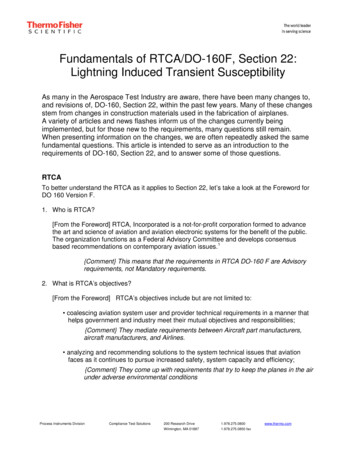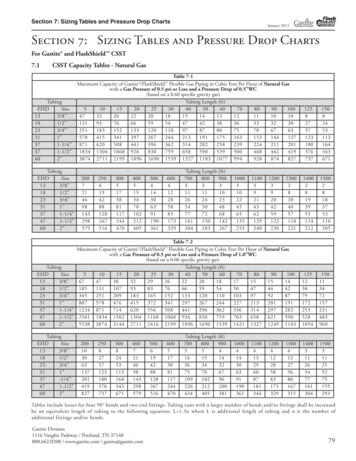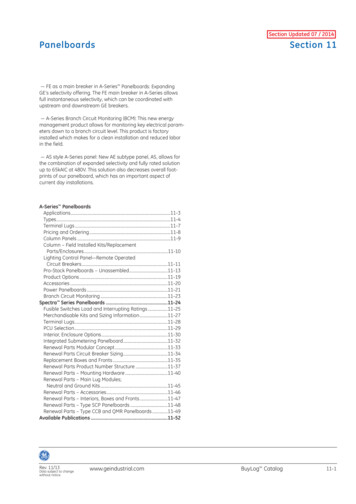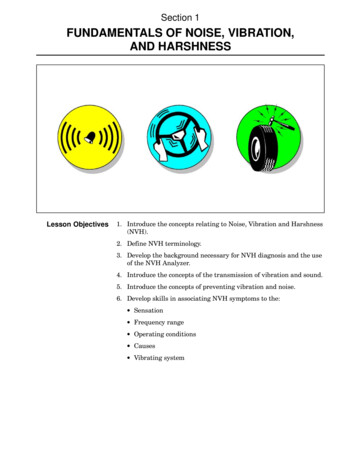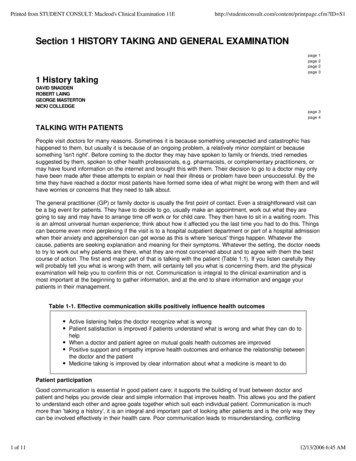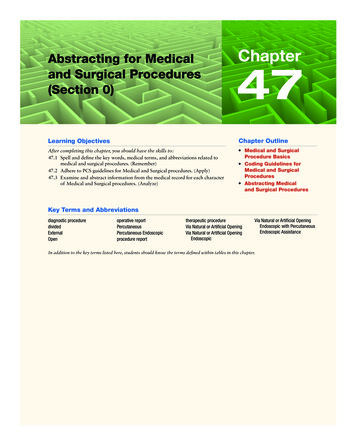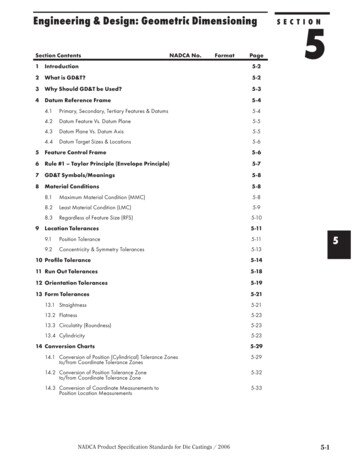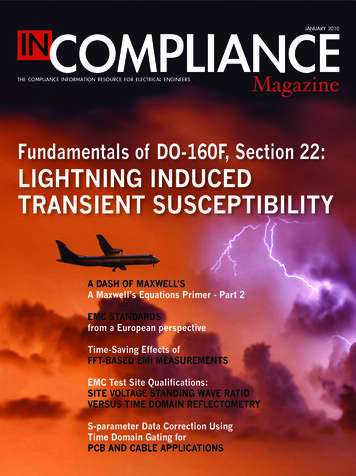
Transcription
JANUARY 2010THE COMPLIANCE INFORMATION RESOURCE FOR ELECTRICAL ENGINEERSMagazineFundamentals of DO-160F, Section 22:LIGHTNING INDUCEDTRANSIENT SUSCEPTIBILITYA DASH OF MAXWELL’SA Maxwell’s Equations Primer - Part 2EMC STANDARDSfrom a European perspectiveTime-Saving Effects ofFFT-BASED EMI MEASUREMENTSEMC Test Site Qualifications:SITE VOLTAGE STANDING WAVE RATIOVERSUS TIME DOMAIN REFLECTOMETRYS-parameter Data Correction UsingTime Domain Gating forPCB AND CABLE APPLICATIONS
WHAT’S INSIDE6 Fundamentals ofDO-160F, Section 22:LIGHTNING INDUCEDTRANSIENT SUSCEPTIBILITYOF MAXWELL’S18 AA DASHMaxwell’s Equations PrimerPart 2STANDARDS28 EMCfrom a European PerspectiveEffects of34 Time-SavingFFT-BASED EMI MEASUREMENTS26 THE iNARTE INFORMERTest Site Qualifications:44 EMCSITE VOLTAGE STANDINGWAVE RATIO VERSUS TIMEDOMAIN REFLECTOMETRYData52 S-parameterCorrection UsingTime Domain Gating forPCB AND CABLE APPLICATIONS42 THE FUTURE OF EMCENGINEERINGTo DILBERT ornot to DILBERT.That is the question.Visit incompliancemag.comand vote TODAY!January 2010 IN Compliance 3
LET TER FROM THE EDITORDear Readers,Welcome to the first monthly issue ofIN Compliance Magazine, a start-uppublication being brought to you topick up where an old friend left off.IN Compliance launched with ourPremiere Issue in Austin, Texas at the2009 IEEE International Symposium onElectromagnetic Compatibility wherewe were welcomed with open armsby the gracious community of EMCprofessionals we had been serving inanother capacity for the past 13 years.As folks came by the booth, manystopped and said, “Oh yeah I get yourmagazine, but it hasn’t been getting tome lately.” And we took a moment totalk with them to let them know thatwe are a new publication, started by thesame team that produced Conformity,but now serving the compliancecommunity as a new entity.We are a women-owned publishingcompany, publishing IN ComplianceMagazine with our solid commitment tofurthering the exchange of information,education and ideas regarding thedesigning, testing, manufacturing andmarketing electronic products to meetglobal compliance requirements.We’ll be publishing IN Complianceevery month with a special AnnualGuide edition published in March.We also host a continuallyexpanding web presence atwww.incompliancemag.com wherereaders can catch up on the latest newsin compliance. To continue receivingthe magazine each month, please take amoment to fill out the subscription cardon the face of this issue, or go onlineto www.incompliancemag.com and fillout the online subscription form. We’veincluded a special offer code in thisissue for a free subscription. For thoseof you (and we know there are many)who are concerned with the impact ofa print publication on the environment,IN Compliance Magazine is printedon recycled stock with soy based inks,severely reducing the impact on ourenvironment but we also offer a digitaledition if you prefer to receive themagazine in digital format.I hope you enjoy this January issue.Our authors have done some amazingwork this month and we are gratefulfor their contributions. We also extendthanks to our advertisers who support uswith their presence in each issue. Andto you, our readers, we thank you foryour continued support and feedback.Oh! Don’t forget to vote on whether toinclude Dilbert in our monthly line-up.We stand ready to follow your wishes,so let us know by entering your vote inour online poll – To Dilbert or Not toDilbert.Cheers!LorieMagazineLorie NicholsPublisher & Editorlorie.nichols@incompliancemag.comIN Compliance MagazineISSN 1948-8254 (print)ISSN 1948-8262 (online)is published bySame Page Publishing LLCP.O. Box 235Hopedale, MA 01747tel: (508) 488-6274fax: (508) 488-6114Sharon SmithDirector of Salessharon.smith@incompliancemag.comErin C. FeeneyDirector of Media Serviceserin.feeney@incompliancemag.comIN Compliance Magazine subscriptions withinNorth America are 24.95 per year (12 issues). Subscriptionsoutside North America are 124.95 per year (12 issues).The Digital Edition is free.Please contact our circulation departmentat circulation@incompliancemag.comFor information about advertising with IN Compliance,please call 978-760-0093 ore-mail sharon.smith@incompliancemag.com.Copyright 2009 IN Compliance Magazine, all rights reserved.Contents may not be reproduced in any form without the prior consent of the publisher.While every attempt is made to provide accurate information,neither the publisher nor the authors accept any liability for errors or omissions.4 IN Compliance January 2010www.incompliancemag.com
Fundamentals ofRTCA/DO-160F, Section 22
byLouis A. FeudiandRobert GivenThermo Fisher ScientificLightning InducedTransient Susceptibility
FEAT U R E Lightning Induced Transient SusceptibilityOver the past few years,the standard RTCA/DO-160,Section 22 has undergonemultiple revisions. As a memberof the Aerospace Test Industry,I regularly receive articles andnews informing me of the latestchanges being implemented to thestandard. However, for others whoare new to the requirements, manyquestions are left unanswered. Inmy travels, I am often asked thesame fundamental questions. Thisarticle is intended to introduce therequirements of DO-160, Section22, and to address some of thosefundamental questions.WHAT IS THE RTCA?To better understand the RTCA as it applies to Section 22,let’s take a look at the Foreword for DO-160 Version F.WHO IS RTCA?The Radio Technical Commission for Aeronautics, organizedin 1935 and now known as RTCA, Inc. includes roughly 335government, industry and academic organizations from theUnited States and around the world. For a clear understandingof the organization we refer to the Foreword: RTCA,Incorporated is a not-for-profit corporation formed to advancethe art and science of aviation and aviation electronic systemsfor the benefit of the public. The organization functions as aFederal Advisory Committee and develops consensus basedrecommendations on contemporary aviation issues.[1]Author’s Commentary: This means that the requirements inRTCA DO-160 F are Advisory requirements, not Mandatoryrequirements.8 IN Compliance January 2010WHAT ARE RTCA’S OBJECTIVES?Again, let us refer to the Foreword for DO 160F to answer thisquestion. RTCA’s objectives include but are not limited to:yy coalescing aviation system user and provider technicalrequirements in a manner that helps government andindustry meet their mutual objectives and responsibilities;Author’s Commentary: They mediate requirements betweenAircraft part manufacturers, aircraft manufacturers, andAirlines.yy analyzing and recommending solutions to the systemtechnical issues that aviation faces as it continues to pursueincreased safety, system capacity and efficiency;Author’s Commentary: They come up with requirementsthat try to keep the planes in the air under adverseenvironmental conditions.yy developing consensus on the application of pertinenttechnology to fulfill user and provider requirements,including development of minimum operationalperformance standards for electronic systems andequipment that support aviation;Author’s Commentary: They get both airplanemanufacturers and component manufacturers to agree ona minimum operational performance standard while theproduct is being stressed (immunity).and;yy assisting in developing the appropriate technical materialupon which positions for the International Civil AviationOrganization and the International TelecommunicationsUnion and other appropriate international organizations canbe based.[1]Author’s Commentary: Worldwide Organizations adoptthese requirements as their positions on issues that arise.HOW IMPORTANT ARE RTCA’S STANDARDS?Looking again at the Foreword for DO-160F, we learn thatthe organization’s recommendations are often used as thebasis for government and private sector decisions as wellas the foundation for many Federal Aviation Administrationtechnical Standard Orders. Since RTCA is not an officialagency of the United States Government, its recommendationsmay not be regarded as statements of official governmentpolicy unless so enunciated by the U.S. governmentorganization or agency having statutory jurisdiction over anymatters to which the recommendations relate.[1]www.incompliancemag.com
FEAT U R E Lightning Induced Transient SusceptibilityAuthor’s Commentary: When an aircraft manufacturer(Boeing, Airbus, DeHavilland, Embraer, Fairchild, GeneralDynamics, Goodyear, Grumman, Gulfstream American,etc.) is deciding on purchasing criteria for its Tier one,two and three vendor parts, it can use any or all of therequirements in the standard as part of its buying criteria.That means almost all of the electronics incorporated intoan airplane need to meet some part of this standard.concurs with RTCA on the environmental conditions and testprocedures set forth herein. When approved by EUROCAE,this document will be identified jointly as RTCA DO-160E/EUROCAE ED-14E.[1]Author’s Commentary: The Europeans have similar if notidentical requirements, when the standard is adopted asRTCA DO-160E/EUROCAE ED-14E.WHO ELSE USES THESE STANDARDS?WHAT IS THE SAE?We find the answer to this question also in the Foreword of thestandard: These standards were coordinated by RTCA SC-135with the European Organisation for Civil Aviation Equipment(EUROCAE) Working Groups (WGs) 14 and 31. EUROCAESAE International is a global technology information andstandards-setting resource for the aerospace, automotive,and commercial vehicle industries. In addition to standardsdevelopment and publication, SAE holds annual and biennialconferences and tradeshows, periodic industry seminars,student Collegiate Design competitions, all focused on allfacets of transportation.SAE Aerospace is a sub group of SAE International. Theirfocus is on writing Aerospace Standards (AS),which applyto missile, airframe, ground support equipment, propulsion,propeller and accessory equipment; Aerospace RecommendedPractices (ARP), which provide recommendations forengineering design and provide background information andresearch to support those recommendations: and Aerospaceinformation Reports (AIR), which contain generally acceptedindustry engineering data and information.AE-2 is the SAE Lightning Committee established by theAerospace Council of SAE. They draft and publish therecommended requirements for Indirect Lightning Strikes,based largely on industry and SAE research and knowledge.These requirements are very often adopted into RTCA bythe RTCA SC-135 subcommittee, who is responsible for thecontent of DO-160.Figure 1: Current and intended uses for composite materialsin the construction of airplanesThe fundamental document that defined the environment andtest waveforms used in DO-160, Section 22, and accountedfor the lightning data and analysis necessary to supportthese requirements, is SAE ARP5412, “Aircraft LightningEnvironment and Related Test Waveforms,” originallypublished in 1999, and revised to Revision A in 2005. Thisdocument explains where the concepts of Multistroke, MultiBurst and the current test waveforms originated.CHANGES IN REQUIREMENTS OVER THE PASTFEW YEARSFigure 2: A single carbon filament (bottom left to top right)laid across a human hair10 IN Compliance January 2010Many airplane components have to keep working underenvironmental stress conditions. One of those conditions islightning. So many airplane manufacturers specifySection 22 as one of the requirements for critical systems, likeguidance, radar, communications, engine control, heat and aircontrols, etc.www.incompliancemag.com
Lightning Induced Transient SusceptibilityWe sometimes think of avionics as being the navigationand communications equipment, but it also includes enginecontrols, servo motor controllers for control surfaces likeailerons, rudder and flaps, landing gear controls, radar, evensatellite TV, Wi-Fi, and entertainment systems.Revisions E and F of DO 160 are driven by the use ofcomposite materials used for airframe construction on recentplanes like the Boeing 787 Dreamliner and Airbus A380(Figure 1).Carbon Fiber (CF), also known as graphite fiber, or carbongraphite, is a material composed of ultra-thin fibers (0.0050.010mm diameter) of aligned crystalline Carbon atoms (seeFigure 2). The crystalline alignment makes the fiber extremelystrong for its size. Thousands of fibers are twisted togetherto form a yarn, which is often woven into a fabricmaterial. The fiber, combined with a polymer, andheated through various processes, forms a compositematerial that is extremely strong for its lightweightconstruction. This lightweight property makes theuse of Carbon Fiber Composite (CFC) very attractiveto the aerospace industry where weight/thrust ratiosare critical for operation, maneuverability, and fuelefficiency.Prior to CFC materials, the airframe and most otherparts of the airplane were made of metal. Thus, ifa lightning strike occurred at the nose of the plane,during takeoff for instance, the lightning wouldtravel outside the plane to the tail, exit the surface ofthe plane, and continue to ground. The solid metalconstruction of the airframe acted as a Faradaycage, with an extremely low impedance path. Thisprevented coupling of voltages and currents on theinternal wiring of the plane, which usually was routedalong the side of the plane, between the inside of theouter skin and the interior bulkhead. This also greatlyreduced the susceptibility of the mission criticalcomponents located in the plane.F EAT U R Ethe scope of the document, the “standardized external currentwaveforms have in turn been used to derive standardizedtransient voltage and current waveforms which can beexpected to appear on the cable bundles and at equipmentinterfaces. The test waveforms are considered to be adequatefor the demonstration of compliance for the protection of anaircraft and its systems against the lightning environment.” [2]ARP5412 rev A (hereafter referred to as ARP5412) devotesan entire section to the descri
Fundamentals of DO-160F, Section 22: January 2010. IN Compliance 3 . 18. A DASH OF MAXWELL’S . A Maxwell’s Equations Primer Part 2. EMC STANDARDS from a European Perspective. Time-Saving Effects of . FFT-BASED EMI MEASUREMENTS. WHAT’S INSIDE. Fundamentals of . DO-160F, Section 22: LIGHTNING INDUCED TRANSIENT SUSCEPTIBILITY . 6. 28 34. EMC Test Site Qualifications:
